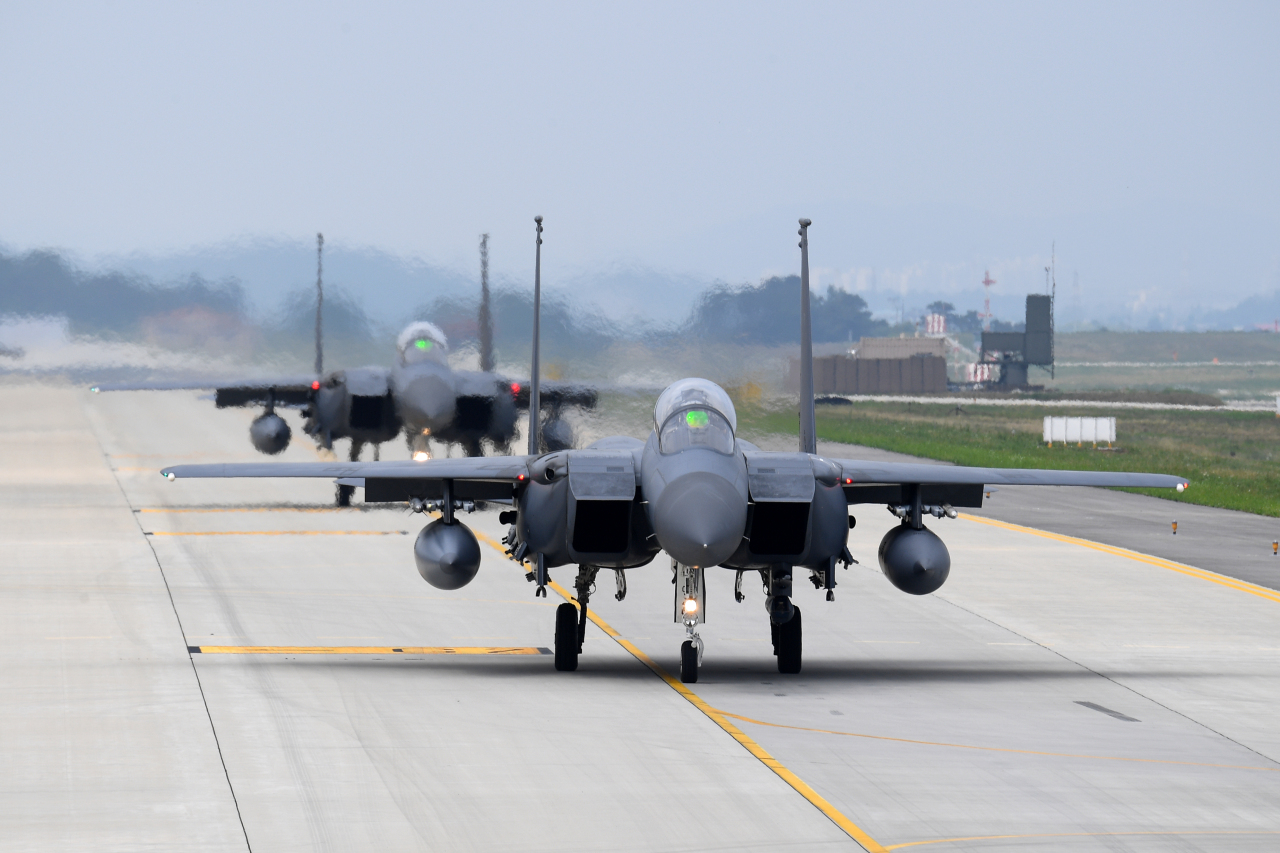South Korea’s air force on Monday kicked off a large-scale aerial military exercise to enhance combat readiness and prepare for possible “enemy provocations,” including a surprise invasion.
The theater-level “Soaring Eagle” combat training exercise is being staged over five days through Friday at the 29th Tactical Fighter Weapons Group located at an air base in the central city of Cheongju, North Chungcheong Province.
South Korea’s air force has conducted the Soaring Eagle exercise twice a year since 2008 with the goal to maintain a firm defense posture in airspace and prepare combat-ready pilots for potential future contingency missions.
The aerial drill is staged in a simulated, high-threat combat environment, which puts fighter pilots and support personnel through scenarios such as a “large-scale, surprise invasion by enemy’s air forces,” the air force said Monday in a statement.
During the Soaring Eagle exercise, South Korea’s virtual friendly force “Blue Air” fights against the virtual enemy, “Red Air.”
The air force explained that pilots are able to “master combat skills to effectively respond to aerial threats posed by the enemy through experiencing the enemy’s tactics” in the simulated environment.
The air force stages various types of military drills, including defensive counter-air operations to detect, identify and intercept enemy air targets as well as large-scale, offensive counter-air operations led by an airstrike package to “punish and strike the core of enemy military forces and the origin of provocations.”
Exercise participants also practice battlefield air interdiction, which is an air operation conducted to destroy an enemy’s military potential such as missile bases and supplies en route to the battlefield, in a simulated combat environment.
“The goals of the exercise are to have the ability to quickly respond to enemy provocations and the best operational capabilities by verifying our ability to strike high-threat targets,” said Col. Lee Chul-woo, head of the 29th Tactical Fighter Weapons Group.
“We will maintain a flawless defense posture in the airspace through intensive and realistic training so that we can immediately and quickly respond to any kind of enemy provocations.”
The Air Combat Maneuver Instrumentation training systems that help fighter pilots accurately understand the battlefield situation and improve their air combat capabilities are also applied to this year’s first Soaring Eagle exercise.
The training systems, which were introduced in late March, provide real-time information such as altitude, direction, location and speed of aircraft flying in the air, and notify of aircraft launching an armed attack.
The air force also seeks to test aerial tactics incorporating fourth-and fifth-generation fighters and their interoperability by operating the fighter jets with different platforms together during the air combat training.
The Soaring Eagle exercise includes approximately 200 military personnel from 19 air force units as well as around 70 aircraft, including the F-35A stealth fighters, F-15K, KF-16, FA-50, F-4E, F-5 fighter jets, KA-1 light attack aircraft, E-737 Peace Eye airborne early warning and control aircraft and CN-235 transport aircraft.
The Soaring Eagle exercise is open to the public for the first time since 2017, although the air force has conducted the large-scale exercise regularly in that time.
The South Korean military had stopped publicly sharing information on the aerial drill in 2018 when the two Koreas thawed relations and established an atmosphere for reconciliation.
The air force has decided to publicly announce the beginning of the Soaring Eagle exercise in around five years in light of the changing security environment on the Korean Peninsula, according to an unnamed air force official. However, the air force did not officially provide the reason for the policy change when asked by The Korea Herald.
Under the Yoon Suk-yeol government, the military expects to publicize standalone and combined military exercises as a counteraction to North Korea’s record-breaking flurry of missile launches.
The South Korean, US and Japanese defense chiefs this month also committed to regularizing and publicizing trilateral warning and ballistic missile search and tracking exercises that have been conducted regularly but at a low profile until now. The decision aims to send a message to the Kim Jong-un regime, which has launched 31 ballistic missiles in less than six months just this year, surpassing the record of 25 in 2019.
South Korea’s Defense Ministry last week announced that the Navy will join the Pacific Dragon multilateral ballistic missile defense exercise in August and separately conduct a live-fire drill to test the ability and performance of surface-to-air missile interceptors in July.
By Ji Da-gyum (
dagyumji@heraldcorp.com)







![[Today’s K-pop] Blackpink’s Jennie, Lisa invited to Coachella as solo acts](http://res.heraldm.com/phpwas/restmb_idxmake.php?idx=644&simg=/content/image/2024/11/21/20241121050099_0.jpg)
